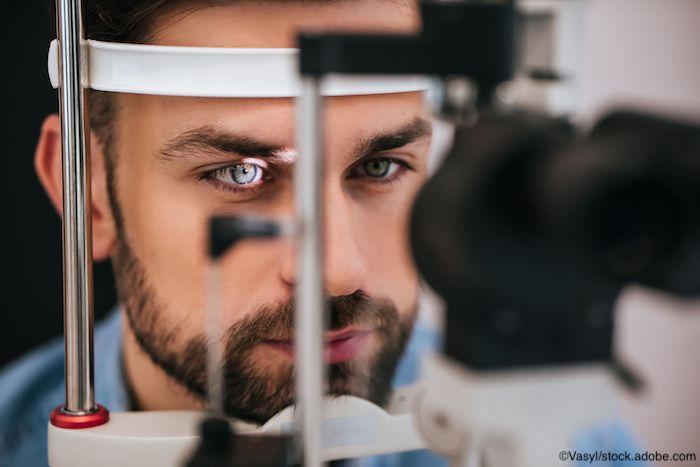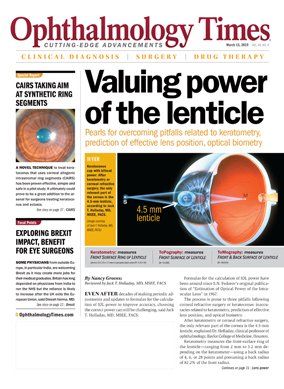Publication
Article
Digital Edition
What clinicians can learn from nitric-oxide donating drugs
Author(s):

Nitric oxide-donating drugs can provide significant reductions in intraocular pressure (IOP) associated with open-angle glaucoma and ocular hypertension compared with timolol, reports Gail F. Schwartz, MD.
In the quest to provide more options to patients with glaucoma, the nitric oxide (NO)-donating drugs can provide significant reductions in IOP associated with open-angle glaucoma (OAG) and ocular hypertension (OHT) in clinical and experimental settings when compared with timolol.
NO offers a few advantages, in that, it can diffuse across cellular membranes and is a potent vasodilator, Gail F. Schwartz, MD.
In addition, it is synthesized endogenously by L-arginine via NO synthase (NOS), which then generates NO, and it activates soluble guanylyl cyclase, which results in up-regulation of cyclic guanosine monophosphate that serves as a second messenger, said Dr. Schwartz, who is in a private glaucoma practice and assistant professor, Wilmer Eye Institute, Johns Hopkins University School of Medicine, Baltimore.
In the eye, NO causes the trabecular meshwork to relax, regulates the permeability of Schlemm’s canal, and causes vasodilation of the ocular blood vessels. In addition, research has shown that dysfunction of the NO-guanylyl cyclase pathway is associated with an increased incidence of glaucoma, which provides insight into the drug’s mechanism of action.
How NO works
In normal eyes, she explained, NO is involved with IOP homeostasis. The conventional pathway in the eye, i.e., the trabecular meshwork and Schlemm’s canal, is IOP sensitive, in contrast to the uveoscleral pathway. With increases in IOP, the cells in Schlemm’s canal are affected by pressure and ultimately collapse; this is the same stress to which vasoconstricted blood vessels are subjected.
When the IOP increases, endothelial NOS (eNOS) is produced and increases the supply of NO that, in turn, relaxes the trabecular meshwork and Schlemm’s canal and increases the permeability of the trabecular meshwork and improves aqueous outflow.
NO in glaucoma
In contrast to the fine-tuned outflow process in normal eyes, in glaucomatous eyes, the IOP homeostasis that depends on NO is disrupted in a few ways.
“eNOS expression is decreased in the ciliary muscle, trabecular meshwork, and Schlemm’s canal,” Dr. Schwartz said. “The levels of NO in the aqueous humor are decreased. Genetic variations in eNOS have been associated with primary open-angle glaucoma [POAG].”
When treating glaucoma, systemically administered nitroglycerin reduces the IOP in OAG, but not in closed-angle glaucoma because the NO cannot reach the trabecular meshwork, which eliminates the incremental benefit of latanoprost (Xalatan, Pfizer) when it is administered alone. When administered topically, nitroglycerin has been shown to reduce IOP in primates; increased dietary intake of nitrate contained in green leafy vegetables can lower the risk for POAG.
Latanoprostene bunod (LBN) 0.024% (Vyzulta, Bausch + Lomb) is the only commercially available NO-donating drug. LBN works when it is broken down by corneal esterases into latanoprost acid and butanediol mononitrate, the latter of which then breaks down into 1,4-butanediol and NO, Dr. Schwartz said.
The NO effect
The action of LBN raises the question about which component of the drug has the positive effect on the IOP-the latanoprost or NO?
Dr. Schwartz explained that LBN relaxes trabecular meshwork cells in vitro, which latanoprost does not. LBN lowers the IOP in both FP receptor knockout mice and prostaglandin-non-receptor rabbits, which latanoprost also does not.
“Higher concentrations of latanoprost over 0.005% do not lower IOP better than lower concentrations possibly because of saturation of the FP receptors,” she noted.
Clinical trials
The phase II VOYAGER 28-day dosing study compared LBN 0.024% with latanoprost 0.005% in patients with OAG and OHT. The study showed maximal IOP lowering with LBN 0.024% and 0.040%.
“LBN significantly reduced IOP by 2 mm Hg or more in 45% of patients compared with latanoprost 0.005% alone,” she said. “A greater proportion of patients taking LBN had an IOP below 18 mmHg at all visits compared with latanoprost.”
The phase II, sleep lab crossover Constellation Study included patients with OAG and OHT with a baseline IOP over 22 mm Hg. The researchers reported that LBN improved the ocular perfusion pressure compared with timolol (nocturnal) and baseline (p = 0.01 and p < 0.006, respectively). LBN also significantly (p = 0.004) reduced the nocturnal IOP by -2.25 mm Hg compared with the -0.1 mm Hg-reduction seen with timolol.
The Jupiter Study, an open-label, single-arm, 1-year safety study, included patients with OAG and OHT, three-quarters of whom had an IOP below 21 mm Hg. LBN achieved a significant (p = 0.001) 26% reduction in IOP that was sustained over the course of the study.
The phase III, 1-year Apollo and Lunar studies compared LBN 0.024% with timolol 0.5%. The results showed that at 17 of 18 time points, the IOP in patients taking LBN was lower than in those taking timolol; the average IOP reduction was 32% compared with baseline. The IOP decrease was sustained to week 52 of the study.
LBN has received approval for clinical use to treat OAG and OHT. A boon for patients is its once-daily dosing. The adverse effects seen with LBN are similar to those with latanoprost (hyperemia, ocular irritation, eye pain, and pain at the installation site).
In the pipeline
Nipradilol, a NO-donating beta-blocker, is being studied in Japan and is reported to be comparable to timolol 0.5%.
Two other NO-donating drugs are being developed. NCX 470 is a NO-donating bimatoprost that caused significant IOP lowering compared with bimatoprost alone in pre-clinical studies. NCX 667 is a NO-donor drug without a prostaglandin. It reportedly lowered IOP significantly and sustained the decreases in rabbits and monkeys. NO-donating dorzolamide and brinzolamide are being studied.
“LBN 0.024%, which is currently available, lowers IOP better than timolol or latanoprost administered separately,” Dr. Schwartz concluded. “NO donors are a new and safe addition to our glaucoma drug armamentarium because they are safe and lower IOP with complementary mechanisms. Additional research is under way into the effects of NO in the eye.”
Disclosures:
Gail F. Schwartz, MD
E: schwartzgf@gmail.com
Dr. Schwartz receives lecture fees from Aerie Pharmaceuticals and Allergan and is a consultant and advisor to Allergan.

Newsletter
Don’t miss out—get Ophthalmology Times updates on the latest clinical advancements and expert interviews, straight to your inbox.




